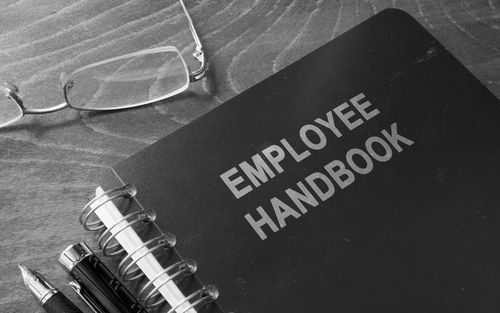An employee handbook is that thing you drafted when you first started your business that laid out the rules for your company. It’s the one that includes the definition of what you can wear on casual Friday. An employee handbook is as diverse as the business. Did you spend more time drafting the dress code than you did the benefits package? Have you looked at it since you made your first dollar? Does that one-size-fits-all template from the internet comply with state law?
A well-written employee handbook can save the employer time and money in the long run. Time is saved when a dispute arises with an employee and a solution is contained in your handbook. Money is saved because the employer devotes fewer resources to investigate and decide on the dispute. A poorly written or out-of-date handbook can do the opposite.
Is your employee handbook up to date? Here are some of the basics.
Benefits
Employee benefits include sick leave, including the Family Medical Leave Act (FMLA), vacation, paid time off (PTO), bereavement leave, and jury duty. It also includes health insurance, dental insurance, vision insurance, employer contribution to a retirement plan, use of a company car, and use of a company credit card. The list goes on and on. Employers should make it clear when an employee is entitled to use benefits. Is the employer better off having a separate designation for vacation time and sick time? Or is the employer better off lumping everything together into PTO? How will the benefits be paid out to the employee at the end of employment? What happens if an employee abuses the privileges of the benefits?
In 2015, the United States Supreme Court held in Obergefell v. Hodges that the Constitution guaranteed a right to same-sex marriage. This right is protected under federal law. It affects FMLA and nondiscrimination policies. Failure of the employer to provide these benefits based on gender identity or sexual orientation could lead to a discrimination case in federal court. Does your employee handbook reflect this change in the law?
Reasonable Accommodations For Disability
The American Disability Act (ADA) applies to businesses that employ 15 or more employees. Under the ADA, employers must make a reasonable accommodation to allow an employee with a disability to enjoy the same work environment and opportunities as an employee without a disability.
The employer is not required to provide a reasonable accommodation if it would cause undue hardship to the employer. Some prohibitive factors could include cost, workforce shortage, or a change in the essential job functions. You can read more about reasonable accommodation requirements here.
Is the employer required to make reference in the handbook to reasonable accommodations if it is already federal law? No. But there is no harm in including a reference to this and other languages related to discrimination practices. The more an employer can incorporate state and federal law into the employee handbook for answers, the more assurance the employer can feel that the employee handbook, the employer’s policies and procedures, and the employer’s reaction to a discrimination claim has reduced the employer’s potential liability.
Social Media
You are probably reading this article through a link you found on social media. Our lives are surrounded by social media sites, apps, devices, and trends. A large number of employers get their message out to a wide audience through social media. It’s inescapable.
A good way to establish your social media policy is to set clear expectations. Are employees completely prohibited from using any type of social media while at work? Are employees only permitted to use social media if it promotes the business? What is the discipline for an employee who violates this policy?
North Dakota does not permit an employer to discipline or terminate an employee for engaging in a lawful activity outside of work that is not in direct conflict with the employer’s essential business-related interests. If an employee is using social media on his or her own personal device and it is not during a time when the employee should be working, the employer may not be able to enforce its social media policy. If the employer used a one-size-fits-all template from the internet, the handbook may be silent on this issue.
Computer Usage
In the same vein as social media, you are probably reading this article on a computer. A large number of employees use computers as their primary work equipment. Computers are an extremely convenient tool. But there are some obvious liabilities.
Again, set clear expectations. Employees are expected to use the internet responsibly, which includes visiting websites, sending emails, and downloading files. Is internet access limited only to job functions? Should the employee be aware of any tracking software the employer implements? Is there a clear protocol for sending and receiving files with clients, businesses, or random strangers?
Discipline And Grievances
From time to time employees will violate the employer’s policies and procedures. When this happens, a clear discipline policy will set expectations for both the employee and the employer. A discipline policy can be implemented in steps (e.g., progressive, tiered, or graduated) where discipline for a first violation is not as severe as discipline for a subsequent violation. The discipline policy can state explicitly which violations of the policies and procedures will result in immediate termination.
An employee who believes he or she was wrongfully disciplined may want to file a grievance within the company. Does the company grievance policy provide a clear structure? Who within the company is to receive the complaint? Who within the company is to investigate the complaint? Is there any whistleblower protection for employees who participate in the investigation?
A large number of employment discrimination claims are made after the employee is terminated. Even though North Dakota is a “right to work” state, if the employee can prove the employer terminated for a discriminatory reason, the employer may be paying out big bucks in a lawsuit. However, if the employer can point to a specific violation of the employee handbook, and the appropriate discipline for the violation, it will greatly reduce the chances of the employee showing that termination was based on discrimination.
Regardless of how fun and interesting an employer’s handbook can be, it is only effective if the employer is willing to implement the policies contained within.
If you have questions about whether you need an employee handbook, or you think your employee handbook could use an update, call the SW&L Team at 701-297-2890.
The information contained in this article and on this website is for informational purposes only and not for the purpose of providing legal advice. You should contact an employment law attorney to obtain advice with respect to any particular issue or problem.









